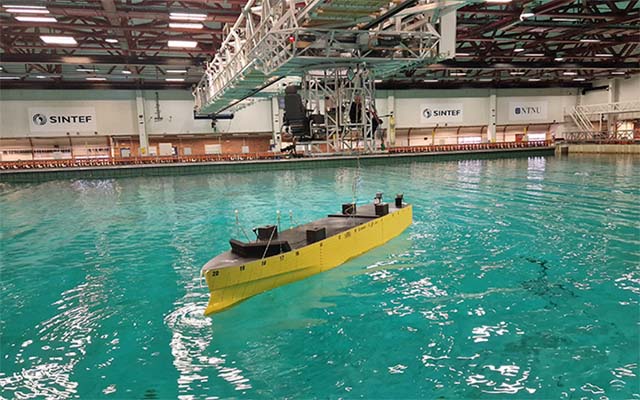The Sea Zero project, being undertaken by Vard and Hurtigruten to find optimal design methods suitable for zero-emission ships has completed a phase of rigorous testing at Sintef Ocean’s facilities in Trondheim.
Large battery packs, retractable sails, air lubrication systems, contra-rotating propellers and an energy-optimised hull are among the innovations being evaluated. With the help of Vard, Hurtigruten wants to design a ship that can sail without emissions in normal operation on the Norwegian coast from around 2030.
Gerry Larsson-Fedde, COO Hurtigruten, said: “We are learning a lot from these tests, and we now see that many of the ambitious goals in this project can also be implemented in practice.”
Following months of testing, the ship design has been further refined to be longer, lower, and more stable, now featuring two large retractable sails, that can be raised or lowered as needed. The recent digital simulations and physical trials in Trondheim, using an 8m model tested in Sintef’s ocean basin and towing tank, confirmed that the sails alone could reduce energy consumption by 10–15%.
The Sea Zero concept aims to cut energy between 40-50% compared to today’s ships. With that reduction, batteries charged with shore power connectivity in key ports could make emission-free operations possible.
Larsson-Fedde said: “For each round we make changes to optimise the design. Now the ship is 8m longer and slightly wider, and the height has been reduced by one deck. This provides, among other things, better stability. We have also gone from three to two sails,”
Trond Johnsen, Project Manager Sea Zero, added: “With the reduction in energy use we’re aiming for, it’s realistic to fit a battery system with enough energy to allow the ship to sail between charging ports under normal weather conditions.”
Hurtigruten is working closely with Norwegian research institute Sintef and other leading partners to refine the design.
Anders Alterskjær, Research Manager Sintef Ocean, said: “To fully understand and analyse how these technologies work together, we are using advanced numerical simulations and have developed new laboratory techniques and instrumentation for ship model testing. The model tests and analyses performed so far show encouraging results towards reducing the energy demand to the degree needed to enable zero emission operation.”
Image: Model tests at Sintef Ocean (source: Vard)



